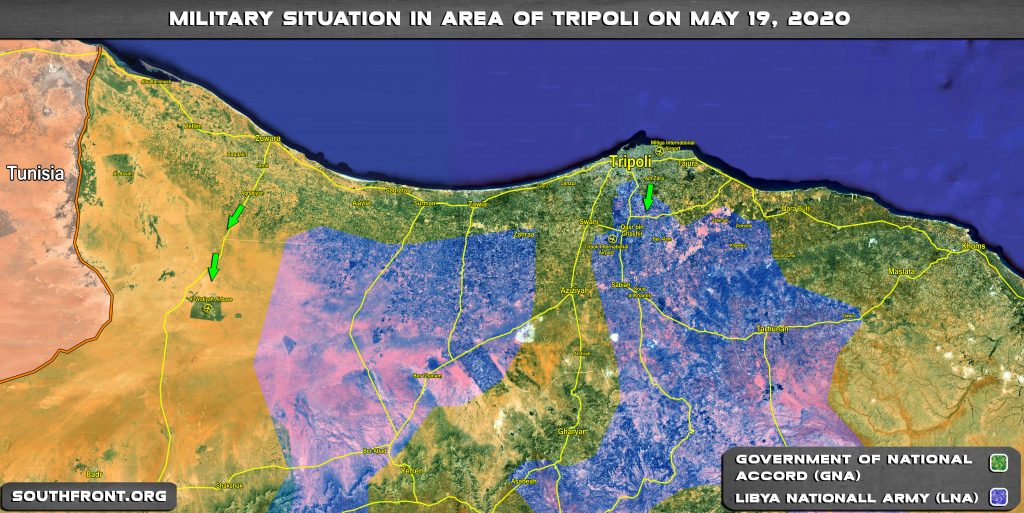The Turkish-backed Government of National Accord (GNA) has announced that its forces have captured the strategically important Watiya Air Base from the Libyan National Army.
The operation follows the announcement by Khalifa Haftar, commander of the Libyan National Army, in late April that he was terminating the UN-brokered political agreement with the Government of National Accord, claiming that his forces have a ‘popular mandate’ to rule the country. Although the agreement was intended to bring the two main belligerent groups together in a unity government, both sides frequently accused the other of breaching the agreement and armed hostilities continued.
The capture of the air base, located approximately 140 kilometres southwest of Tripoli, constitutes a major victory for the GNA forces, which have received a substantial boost in materials, troops and morale due to the increasing support it has received from Turkey over the last few months. While many regional powers, as well as numerous NATO countries and Russia, are widely considered to be directly and/ or indirectly supporting one side or the other in violation of a UN arms embargo, Turkey is the only country to have publicly declared its direct support for one of the belligerent parties and active participation in the conflict.
Turkey signed a bilateral agreement with the GNA in November of 2019 in defiance of the UN embargo, and in return was granted access to gas fields in the Mediterranean (a move that received an angry response from Greece in particular, which also claims sovereignty over the area affected). Turkey initially limited its support to weapons supplies and sending some advisors and technical experts, however more recently it has officially deployed some of its own troops supplemented by the transfer of up to several thousand militias from the battlefields of northern Syria.
The increasing participation of a foreign power in the conflict in Libya has inevitably brought other foreign powers to increase their involvement, aggravating the situation as developments in the country become enmeshed in broader regional and international disputes and rivalries for influence, resources and power.
It appears that Turkey can rely on the support of Qatar due to their close bilateral relationship (particularly the crucial support Turkey provided when Saudi Arabia and the United Arab Emirates announced the blockade against Qatar), as well as the support of several NATO countries (at least unofficially). Not surprisingly, the United Arab Emirates and Saudi Arabia have denounced Turkey’s increased participation in the Libyan conflict and have in turn increased their support to the Libyan National Army, which also receives support from Egypt and possibly also indirectly from Russia, with numerous reports of Russian mercenaries (contractors of the company Wagner Group) present in the country.
A report filed earlier by the Libyan Observor quoted officials as saying that:
“GNA forces had seized Al-Watiya and all military equipment inside it from Haftar’s forces, including a Russian Pantsir anti-aircraft system that was provided by UAE to help Haftar in his war on Tripoli.”
The agency also refers to a news report from Turkey concerning weapons shipments from the UAE:
“A company from the United Arab Emirates (UAE) has purchased six helicopters and two boats to raid ships off Libya in a move to support Khalifa Haftar in his ongoing war on Tripoli, a UN panel report revealed, according to Anadolu Agency.
According to confidential letters by a Panel of Experts, under the Security Council’s Libya Sanctions Committee, the sale of at least $18 million in military equipment was made through a Jordan-based company that was founded by Fulcrum Holding in the UAE.”
The shipment is reported to have included three Puma helicopters made in South Africa, and three French-built SA 341 attack helicopters purchased from Gabon.
The international entanglements are described in report by Deutsche Welle, commenting on the German government’s acknowledgement of weapons exports to several countries involved in the Libyan conflict despite the UN arms embargo. In this respect the report states that although Germany officially supports the arms embargo:
“Since hosting a Libya summit four months ago, the German government has approved arms exports worth €331 million ($358 million) to countries accused of supporting warring parties in the country, according a report from the German Economy Ministry seen by news agency DPA.
Between January 20 and May 3, Germany approved €308.2 million in arms destined for Egypt alone, the ministry said. The information was provided in response to a request from Germany’s leftist die Linke party.
The German government also approved €15.1 million in arms exports for Turkey and €7.7 million for the United Arab Emirates (UAE), DPA reported.
Turkey supports the Government of National Accord (GNA), which is backed by the UN, while Russia, Egypt, and the UAE support rival forces led by Khalifa Haftar…
Egypt, Turkey, Russia, and the UAE were among the signatories. United Nations Secretary-General Antonio Guterres later accused these four countries of breaching the embargo and continuing to provide arms for the conflict.
‘I am deeply frustrated with what’s happening in Libya,’ Guterres said at a press conference in February. ‘They committed not to interfere in the Libyan process and they committed not to send weapons or participate in any way in the fighting. The truth is that the Security Council (arms) embargo remains violated.’”
While the recent military gains of the Libyan National Army achieved with Turkey’s assistance have improved their position considerably and could pave the way for further advances, they are also likely to provoke a response from Turkey’s rivals and further escalate the conflict in Libya.






